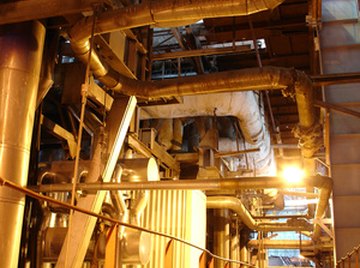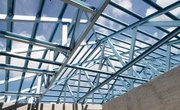
Alloy steel is a mixture of iron ore, chromium, silicon, nickel, carbon and manganese, and it is one of the most versatile metals around. There are 57 types of alloy steel, each with properties based on the percentage amount of each element mixed into the alloy. Since the 1960s, electric furnaces and basic oxygen furnaces have been the standard forms of industrial alloy steel production, while other methods have become outdated. The technology of steel production and the quality of output have advanced, but the actual steps to manufacturing alloy steel have not changed and are rather simple to understand.
- Iron ore
- Coke
- Chromium
- Silicon
- Nickel
- Carbon
- Nitrogen
- Manganese
- Limestone
- Electric steel production furnace
- Hydrofluoric acid
- Industrial steel-cutting shears
- Industrial steel-cutting saws
- Plasma or ionized gas-cutting equipment
Use either the basic oxygen furnace or an electric furnace for steel production because they are both more efficient than older methods.
Avoid using open-hearth furnaces and Bessemer converters because they are obsolete. Modern steel production facilities are more efficient and strict air pollution regulations have shut down Bessemer converter facilities.
Melt the base alloys in an electric furnace at 3,000 degrees Fahrenheit for 8 to 12 hours. Then anneal the molten steel by rapidly cooling and heating it in a controlled sequence. Heat to 1,000 degrees Fahrenheit for four hours and then cool to 35 degrees Fahrenheit with water for two hours. Annealing reduces impurities in the molten steel and improves bonding between the base elements. Let the steel cool in the air for four hours.
Dip the steel in a bath of hydrofluoric acid. The dip removes the buildup of mill scale caused by annealing. Mill scale is an iron oxide that peels from the surface of hot steel when it is air-cooled. Anneal and descale the steel one more time. Then heat the steel so it is molten again, at 3,000 degrees Fahrenheit for eight hours.
Pour the molten unfinished steel into casts, blooms, billets and slabs. Blooms are long rectangular bars; billets are round or square ingots; and slabs are long, thick sheets. Cast the blooms, billets and slabs by pouring them into molds and allow them to cool for four hours. Further cool the steel blooms, billets and slabs to 200 degrees Fahrenheit by speeding them along a fast-moving conveyor belt. Alternate between cooling them in the air and pressing them through a series of rollers.
Roll the blooms, billets and slabs through heated rollers to shear off the ends as scrap and to burn away surface defects. Each rolling method brings the steel closer to the final product. Roll the blooms into steel bar, billets into wire and strips and slabs into sheet steel and steel plate. Then roll the steel through hot presses for a dull finish, or send it through a series of hot and cold presses for a polished finish. Use a series of grinders and abrasive rollers for a reflective finish.
Cut the steel down to the products requested by the end users and divide up into orders. Other production facilities will further process the steel and fabricate the end products. Use industrial shears for cutting steel wire, sheet steel and strips, and use industrial saws for steel bar. Cut through steel plate with industrial plasma torches or ionized gas torches. Cut the final product down for shipping by rail, so the steel weighs anywhere from a few hundred lbs. to 40 tons, depending on whether it is steel sheeting, steel wire, steel plate or steel bar.
Things You'll Need
Tips
Warnings
References
Tips
- Use either the basic oxygen furnace or an electric furnace for steel production because they are both more efficient than older methods.
Warnings
- Avoid using open-hearth furnaces and Bessemer converters because they are obsolete. Modern steel production facilities are more efficient and strict air pollution regulations have shut down Bessemer converter facilities.
About the Author
Barry Index lives in Los Angeles where he has been writing about writing since 1998. Recent freelance activities have brought his work to wider audiences through FictionAnitdote.com and several other writer-enthusiast sites. He received his Bachelor of Arts degree in English from California State University, Northridge.
Photo Credits
pipes image by Andrei Merkulov from Fotolia.com
